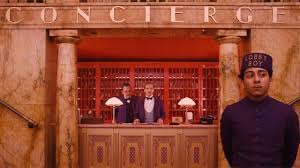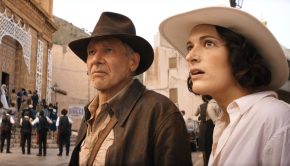Inside the Design of The Grand Budapest Hotel
We show some much deserved love to the attention to detail behind the physical particulars of Grand Budapest Hotel, from set design to the props.
The captivating story of the Grand Budapest Hotel is like little you’ve seen before. What makes this movie so charming? You’ll find the answers in the well-developed details. The inspiration for the Hotel is a novelist that is sadly unknown to many; his name is Stefan Zweig and it is said that he was the most understated novelist of the 1920s. Anderson lives in this wonderful realm of understatement. The film revolves around the unorthodox relationship between two unlikely friends, Zero and M. Gustave, getting into the most outrageous adventures, from running the hotel itself to careening down the side of a mountain in a race against death. While there is a lot to be said about the story and characters, the look of the movie is almost a character in itself. Wherever Zero and Gustave go they are accompanied by beautiful landscapes, hotels, and L’Air de Panache. It’s a movie that comes alive on many fronts thanks to its design, from the concepts themselves to the physical props and set decoration.
The set designs in the film appear vast; the Grand Budapest Hotel is a magnificent visual, but it isn’t real. It’s a small replica of Wes Anderson’s dreams, modeled loosely after the Grandhotel Pupp in Karlovy Vary, Czech Republic. Something that stood out to the set designer Adam Stockhausen was the beautiful pastel colored building and while he loved it he decided to make his own that was much more exquisite.
The Grandhotel Pupp
The hotel interiors were constructed inside an abandoned department store near the Polish border called the Görlitz Warenhaus; to see the original in comparison to what it became is a magnificent transformation.
Görlitz Warenhaus (before)
Görlitz Warenhaus (after)
The prison scenes were filmed in Zwickau Prison, which was once used as a Nazi camp during the war. The Osterstein Castle it’s located in is currently awaiting museum status, and rightly so. It’s a beautifully preserved institution and a marvel of a set. National Geographic did an excellent piece with the set designer, with more photos of the original locations and their transformed sets.
The props play a big part in creating the whimsical magic of the film as well. Ralph Fiennes’ main character, M.Gustave, has a certain odour about him. L’Air De Panache, to be exact. He wants his cologne to alert guests and staff of his approach, and also to leave a sense memory of himself when he leaves the room. In his obsession with the cologne, he goes as far to have his lobby boy Zero bring it to him upon his escape from prison. Later on in the film both M.Gustave and Zero apply the cologne together — it is a simple and sweet bonding sentiment.
A man who knows the devil is in the details, Anderson wasn’t satisfied with just a prop bottle of cologne; he actually had cologne created just for the film. It consists of mandarin, bergamot and patchouli, and even a hint of green apple. But where can you buy this cologne? It would be insanely difficult to source as there was only enough created to gift to the cast and crew. Though I must say, anything with patchouli in it is an instant turn on for women, especially if accompanied by a purple velvet blazer and a well-groomed mustache. L’Air De Panache could loosely translate to ‘Air of Reckless Courage and Flamboyant Confidence.’ The literal translation of ‘panache’ is a plume, like the famous white feather on the helmet of King Henry IV of France, who when leading men into battle would exclaim, “Ralliez-vous à mon panache blanc!” [“Follow My White Plume!”] There’s no doubt you could follow the scent of Gustave’s cologne. If you do happen to stumble upon a bottle of this sacred scent, you’ll find it in an antique spritzer.
To write about just the original story and fabulous acting will never do the Grand Budapest Hotel any justice. Wes Anderson’s choice of cinematic shots and camera moves add tremendous amounts of character to the film that simply cannot be described in writing (and for all the Bill Murray fans out there you won’t be disappointed with his majestic appearances). But what shines through most is Anderson’s attention to detail — it’s what creates the whimsy in his film universe and its clearly visible in the set design and props of this film. May the beautiful mind of Anderson be the inspiration for your dreams, as it is perfectly suited to this movie, and to all stories as polished as the Grand Budapest Hotel.
Read The Feedback Society’s review of Grand Budapest Hotel.




















